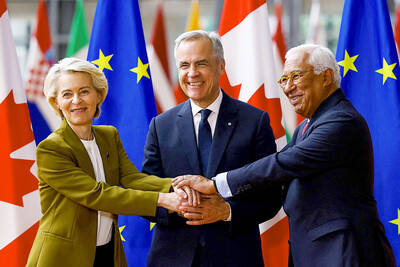Shusaku Tani is employed at the Sony plant, but he does not really work.
For more than two years, he has come to a small room, taken a seat and then passed the time reading newspapers, browsing the Web and poring over engineering textbooks he dug up from his college days. He files a report on his activities at the end of each day.
Sony Corp, Tani’s employer of 32 years, consigned him to this room because they cannot get rid of him. Sony had eliminated his position at the Sony Sendai Technology Center, which in better times produced magnetic tapes for videos and cassettes. However, Tani, 51, refused to take an early retirement offer from Sony in late 2010 — his prerogative under Japanese labor law.
So there he sits in what is called the “chasing-out room.” He spends his days there, with about 40 other holdouts.
“I won’t leave,” Tani said. “Companies aren’t supposed to act this way. It’s inhumane.”
The standoff between workers and management at the Sendai factory underscores an intensifying battle over hiring and firing practices in Japan, where lifetime employment has long been the norm and where large-scale layoffs remain a social taboo, at least at Japan’s largest corporations.
Sony wants to change that, and so does Japanese Prime Minister Shinzo Abe. As Japan’s economic recovery sputters, reducing the restraints on companies has become even more important to Abe’s economic plans. He wants to loosen rigid rules on job terminations for full-time staff.
Economists say bringing flexibility to the labor market in Japan would help struggling companies streamline bloated workforces to better compete in the global economy. Fewer restrictions on layoffs could make it easier for Sony to leave loss-ridden traditional businesses and concentrate resources on more innovative, promising ones.
“I have a single wish for Japan’s electronics sector, and that’s labor reform,” Jefferies & Co technology analyst Atul Goyal said.
Sony said it was not doing anything wrong in placing employees in what it calls Career Design Rooms. Employees are given counseling to find new jobs in the Sony group, or at another company, it said. Sony also said that it offered workers early retirement packages that are generous by US standards: In 2010, it promised severance payments equivalent to as much as 54 months of pay. However, the real point of the rooms is to make employees feel forgotten and worthless — and eventually so bored and shamed that they just quit.
Sony, a sprawling company with more than 146,000 employees, is under pressure. It has been outmaneuvered by more nimble competitors and its executives are trying to remake the company. Fixing Sony is especially critical after it snubbed the US activist investor Daniel Loeb’s push to spin off part of Sony’s entertainment business. Its shares have fallen almost 10 percent since Sony rejected his proposal last week.
Critics of labor changes say something more important is at stake. They warn that making it easier to cut jobs would destroy Japan’s social fabric for the sake of corporate profits, causing mass unemployment and worsening income disparities. For a country that has long prided itself on stability and relatively equitable incomes, such a change would be unacceptable.
“That’s not the kind of country Japan should aim to be,” said Takaaki Matsuda, who leads the Sendai chapter of Sony’s labor union.
It would be a radical change. A combination of lifetime employment, seniority-based pay and intense worker loyalty to the company was credited for Japan’s postwar economic miracle, as stability and growth went hand in hand. However, when the Japanese economy stumbled in the early 1990s, companies found that Japan’s rigid labor practices made downsizing impractical. Instead, unneeded workers were left with little to do besides gaze out of the window, giving rise to the term madogiwa zoku or the “window seat tribe.”
Proponents of employment change say that stiff protections for workers have prompted companies to make major cuts in hiring, shrinking opportunities for scores of younger Japanese. Sony hired 160 fresh college graduates this fiscal year, compared with about 1,000 in 1991.
Companies have also adjusted by using a secondary class of temporary or part-time workers they can more easily let go.
“In reality, hidden inequalities already exist in Japan,” Osaka University economist Fumio Ohtake said.
Still, some fear that Abe’s changes are not so much pro-market as just pro-business. A weaker yen has brought exporters like Sony windfall profits, yet no substantial increases in salary have followed, and many manufacturers continue to shift production overseas.
The delicacy of labor changes has forced Abe to tread gingerly. He took the issue off the agenda when he focused on parliamentary elections last month. After a big win for his party, it is back. However, the new plan would ease firing rules only in Japan’s three biggest cities.
Japan’s biggest companies appear to be imitating Sony in its efforts to get workers to leave. Local media reports say many of them, including Panasonic Corp, NEC Corp and Toshiba Corp, use the oidashibeya, or “chase-out rooms,” and similar tactics. In May, the Asahi newspaper reported that an employee at a Panasonic unit was being required to spend his days in a room staring at monitors to catch any irregularities.
Last year, a Tokyo court ordered Benesse Corp, an educational services company, to reinstate a worker who claimed she had been required to do demeaning, menial tasks after resisting pressure to leave.
Panasonic could not be reached for comment over its summer holiday period. Benesse said it had since revised its personnel practices.
While details of the government plans are still being determined, Tani’s managers at Sony are already upping the ante. Starting this month, the company has ordered him to work 12-hour shifts on an assembly line at a Sony plant in Toyosato, more than an hour’s drive away. He says he will comply.
For Miwako Sato, who joined Sony right out of high school in 1974, the changes are a betrayal of an accepted social contract in Japan. She put in 12-hour shifts at the Sendai factory, working with huge rolls of magnetic film, and watched Sony grow into a global electronics powerhouse.
However, technology moved on, and Sony was increasingly usurped by nimbler rivals. In 2003, the factory offered the first of many early retirement programs.
Two years ago, a destructive tsunami swept through the factory, sending workers scrambling to the roof. The damage prompted Sony to move its battery and optical devices operations, and the company later sold its chemical products business, eliminating more jobs at the plant.
In February, just two years shy of Sato’s retirement, a manager had blunt news: “Your job no longer exists.”
She refused to quit, and was dispatched to the chase-out room. There she completed an online degree in nursing the elderly. However, she did not quit. Since last month, she has been assigned to do data entry.
Sony’s labor union estimates that the plant’s workforce is half the size it was three years ago.
Sato said that in the factory’s heyday, workers called Sony the Sony Maru, or “the Sony Ship.”
“Everybody was on board, our fates tied together,” she said. “Not anymore.”

Drug lord Jose Adolfo Macias Villamar, alias “Fito,” was Ecuador’s most-wanted fugitive before his arrest on Wednesday, more than a year after he escaped prison from where he commanded the country’s leading criminal gang. The former taxi driver turned crime boss became the prime target of law enforcement early last year after escaping from a prison in the southwestern port of Guayaquil. Ecuadoran President Daniel Noboa’s government released “wanted” posters with images of his face and offered US$1 million for information leading to his capture. In a country plagued by crime, members of Fito’s gang, Los Choneros, have responded with violence, using car

CYBERCRIME, TRAFFICKING: A ‘pattern of state failures’ allowed the billion-dollar industry to flourish, including failures to investigate human rights abuses, it said Human rights group Amnesty International yesterday accused Cambodia’s government of “deliberately ignoring” abuses by cybercrime gangs that have trafficked people from across the world, including children, into slavery at brutal scam compounds. The London-based group said in a report that it had identified 53 scam centers and dozens more suspected sites across the country, including in the Southeast Asian nation’s capital, Phnom Penh. The prison-like compounds were ringed by high fences with razor wire, guarded by armed men and staffed by trafficking victims forced to defraud people across the globe, with those inside subjected to punishments including shocks from electric batons, confinement

The team behind the long-awaited Vera Rubin Observatory in Chile yesterday published their first images, revealing breathtaking views of star-forming regions as well as distant galaxies. More than two decades in the making, the giant US-funded telescope sits perched at the summit of Cerro Pachon in central Chile, where dark skies and dry air provide ideal conditions for observing the cosmos. One of the debut images is a composite of 678 exposures taken over just seven hours, capturing the Trifid Nebula and the Lagoon Nebula — both several thousand light-years from Earth — glowing in vivid pinks against orange-red backdrops. The new image

Canada and the EU on Monday signed a defense and security pact as the transatlantic partners seek to better confront Russia, with worries over Washington’s reliability under US President Donald Trump. The deal was announced after a summit in Brussels between Canadian Prime Minister Mark Carney and European Commission President Ursula von der Leyen and European Council President Antonio Costa. “While NATO remains the cornerstone of our collective defense, this partnership will allow us to strengthen our preparedness ... to invest more and to invest smarter,” Costa told a news conference. “It opens new opportunities for companies on both sides of the